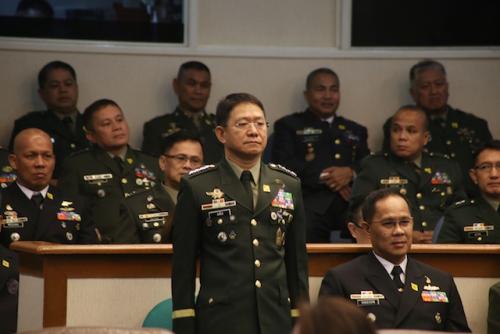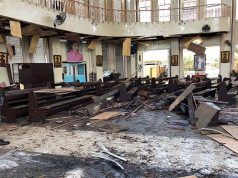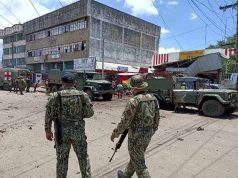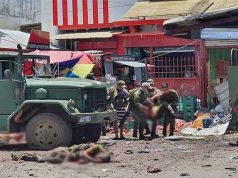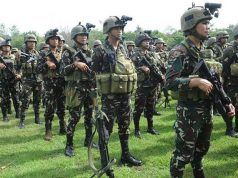(UPDATED – 11:30 p.m.) MANILA, Philippines – Abu Sayyaf bandits are ready to sow terror in any place, outside their lairs in Basilan and Sulu, where there’s an opportunity to raise lots of money via kidnapping.
This was the explanation of Armed Forces of the Philippines (AFP) chief Gen. Eduardo Año on what could have possibly motivated the terrorist group to sail to Central Visayas for the first time from its jungle hideout in Mindanao.
“If you look at the mind of the ASG [members], they’re really just simple people…[They will go] where money can be had, they’ll do that,” said Año during a press briefing on Wednesday, April 12, following the firefight between government forces and the terror group in Inabanga, Bohol, killing 10 and displacing hundreds of residents.
Tourist areas as potential ransom sources
Año said the bandits saw tourist areas in Central Visayas such as Bohol and Cebu as potential sources of huge sums through kidnap-for-ransom activities.
Central Visayas exceeded its tourism target for 2015 by 10.46 percent or 4.5 million visitors, data from the Department of Tourism (DOT) showed.
Foreign arrivals in the region in 2015 mostly from South Korea, U.S., Japan, and China grew by almost 16 percent to 1.9 million while domestic arrivals increased 7 percent to 2.6 million. In the first 11 months of 2016, Central Visayas received a total of 4.9 million visitors.
Bohol, known for its white sand beaches and diving sites, is among the country’s top tourist destinations and best Holy Week vacation getaways. Data from the DOT showed that in 2015, the province received a total of 490,545 visitors, about 35 percent or 169,431 were foreigners. From January to November 2016, Bohol received a total of 820,000 tourists.
Cebu, known as a frequent host-city for several ministerial meetings, received a total of 3.3 million tourists in 2015. In 2016, the province continued to account for the largest chunk of visitors with 3.46 million from January to November.
Asked by reporters on Wednesday if the Abu Sayyaf was targeting leaders from the Association of Southeast Asian Nations amid the summit in the Philippines this month – some Asean meetings were earlier held in Cebu and the others will be held in Bohol later in April – Año said, “I don’t think they’re on that level [already].”
Abu Rahmi’s death a ‘major blow’ to Abu Sayyaf
The AFP chief, meanwhile, confirmed that terror leader Muammar Askali alias Abu Rahmi was among the six Abu Sayyaf members killed in Bohol.
“Our troops recovered another body on the site of encounter,” said Año.
He said the death of Abu Rahmi, who participated in the September 2015 kidnapping of two Canadians, a Norwegian, and a Filipino in a tourist resort on Samal Island in Davao del Norte, was a “major blow” to the terror group.
“The Abu Sayyaf must think twice, our security forces is working challengingly and effectively as they thwarted their plans to sow terror in the area,” said Año.
”I can declare that the threat is over successfully after the siege in Brgy. Napo, Inabanga, Bohol although we are still pursuing some of the remnants of the groups, our assault them continues to scour the area,” the AFP chief added.
Año thanked the Bohol government and the residents for their cooperation.
“We have successfully thwarted an attempt to destroy the peace and security of one of our provinces with the combined determination of your AFP and your PNP, as well as the full cooperation of the citizenry and our local government units in Bohol. May this be an example of bayanihan in the true sense of the word.”
He also extended his condolences to the families of the four from the government’s side who died in the firefight: Second Lieutenant Espelito Saldua, Jr., Corporal Meljun Cajaban, Sergeant John Dexter Duero, and Police Officer 2 Rey Anthony Nazareno.
Five suspected Abu Sayyaf members being tracked down
Año said authorities were still tracking down five other suspected Abu Sayyaf who had escaped after the clash in Bohol.
The AFP chief called on the public to always be vigilant report to authorities any suspicious people in their area.
As the Abu Sayyaf “make a living” out of kidnap-for-ransom, they will continue to do so, while authorities continue to thwart them, according to Año.
He said the military and the police were busy conducting an investigation on the suspects’ “contact” from the local community who had also escaped. Año said he could not yet reveal the person’s identity.
The AFP chief noted that their campaign to “decimate” the Abu Sayyaf was making headway, with 49 members killed out of a total of 116 terrorists “neutralized”. Also, he said a total of 120 firearms had also been recovered from the terror group, with 64 recovered in Sulu in one month alone.
Año was hopeful that the other Abu Sayyaf members would have a “clearer mind” and surrender.
The AFP was still “mopping up” the scene, Año said, to ensure the safe return of hundreds of Bohol residents, who were displaced during the firefight. He said authorities would return the area to the local government unit’s care in due time.
As for three houses that had been occupied by Abu Sayyaf members, these had already been cleared, according to Año. He said that he had also requested the SOCO (Scene of the Crime Operatives) to conduct a “clean sweep” of the area in aid of the investigation.
Aid given to displaced Bohol residents
Meanwhile, the Department of Social Welfare and Development (DSWD) through its Field Office in Region VII, has extended initial assistance to locals who were affected by the operations against the Abu Sayyaf.
Some 593 families from 11 barangays in Bohol had been affected by the armed conflict, the DSWD said.
The agency said some 150 family food packs were already distributed to the displaced locals and another 100 is set to be delivered to the Provincial Social Welfare and Development Office of Bohol.
DSWD Secretary Judy Taguiwalo urged “citizens to remain vigilant and to report any unusual or suspicious activities or incidents we witness or hear of to the authorities.”
“This is particularly intended for those who are traveling to other places for the Holy Week. We need to prioritize the safety of our communities at all times, and we should all be watchful against any suspicious behaviour, packages, bags or vehicles,” added Taguiwalo.
Watch related video by News5’s Jeff Caparas.

